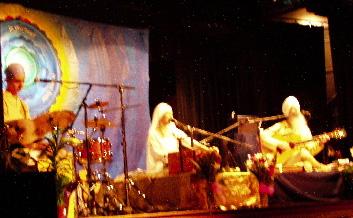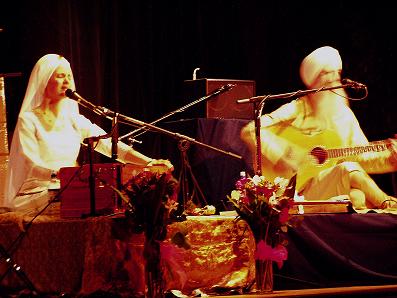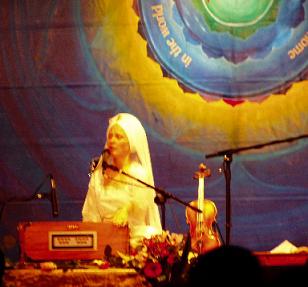NRI News
SNATAM KAUR KHALSA:
A SPIRITUAL MUSIC AMBASSADOR
Snatam Kaur Khalsa is an emerging and celebrated
spiritual music ambassador. Snatam, a Sanskrit word,
meaning universal, nucleus, and friend to all; Kaur,
a Punjabi word and a faith-mandated surname for all
Sikh women, means a princess and lioness; and Khalsa,
a Sikh term that defines the Order of the Pure; Snatam
truly embodies a rare composite of those qualities
through her devotional music and her radiant persona.
Her music is another bridge between the traditions
and cultures of East and West. Snatam Kaur brilliantly
interfaces Gurbani Keertan, the Sikh style of religious
music, and the western classical and popular styles
in her music and concerts. Snatam is popularizing
her own unique style, rhythms, musical arrangements,
and is introducing the Sikh sacred music to global
audiences. Her music transcends traditional musical
familiarities and frontiers, reaches deep into our
soul where Gurmukhi, the language of Sikh scriptures,
offers no formidable threshold that our spirit cannot
cross or joyfully embrace.


Snatam Kaur is many attributes in one. She is an
accomplished music soloist, songstress and poet, Kundalini
Yoga master, spiritual healer, teacher, and cultural
commentator. Her music is a bridge that combines many
musical, cultural, and spiritual textures: of a Sikh
Ragi (a musician well versed in Indian musical patterns
known as Ragas); sacred Sanskrit, Buddhist, American
Indian chants; Celtic song and music tradition, use
of western orchestra, folk genre, jazz, and many other
musical influences.

She presents her music with a deep sense of reverence.
Snatam is modest and approachable, unassuming, and
friendly. Her contagious optimism captures the imagination
and attention to her words, message of peace, and
music as a shared and precious human legacy. With
a gentle passion, she offers:
"For people of all faiths, all walks of life,
and through the power of our own voices singing songs
of peace, we provide a place for the spirit of humanity
to rise."
She reminds us of the words of her mentor, Sri Singh
Sahib Harbhajan Singh Khalsa Yogijee or affectionately,
Yogi Bhajan:
"If you cannot see God in all, you cannot see
God at all."
The sacred Sikh commandments and spiritual wisdom
that formed the foundation of Snatam's faith and her
spirit since she was a young child remind us:
"O mortal, recognize all humanity as One Race,
One Brotherhood."
"Every living being is a repository of Divine
Light."
"No one is outside the circle of God's boundless
benevolence."
Snatam's music and teachings seem to affirm this
deep conviction and respect for all life, cultures,
and faiths. Her interfaith, multi-cultural, and multi-generational
audience and admirers of her music see her as an ambassador
of goodwill and peace.
Snatam's album Shanti, was nominated for a Grammy
in 2002 and made it to the semi-finals in the New
Age music category. This emerging star is now enthralling
audiences of music lovers on her current "Celebrate
Peace" World Tour, sponsored by Spirit Voyage
and Peace Cereal and others, recently brought her
to Indianapolis. Snatam Kaur's Concert, at St. Luke's
United Methodist Church in Indianapolis, was sponsored
by the Indiana Yoga Association and Midland Yoga Center
in Bloomington.
Snatam Kaur Khalsa, dressed in traditional Punjabi
clothes with a neatly-tied white turban supporting
a jeweled Sikh emblem, arrived without much fanfare
and greeted the audience with some opening thoughts
about Naad: Divine Sound Current. The concert venue
was a very intimate space and full to capacity. There
was a remarkable simplicity in the room with a tastefully
decorated stage. A large blue mural with a sacred
lotus design reminded the audience about peace as
a central nucleus of our humanity.
Snatam, playing the harmonium and violin, led a moving
rendition of songs and chants. Accompanying Snatam
were Guru Ganesha Singh on the guitar, dressed in
Punjabi kurta-pajama and the traditional white Sikh
turban and young Krishan on the tabla (a pair of Indian
drums) and percussion instruments dressed in Punjabi
kurta-pajama with a patterned scarf on his head. Guru
Ganesha Singh is a very spirited, exuberant, and expressive
member of the group. Krishan offers youthful energy
and impeccable sense of timing on the tabla and other
musical instruments. Each musician gave an incredible
account of his talent and complimented the richness
of the experience. There seemed to be an invisible
thread guiding their music in perfect harmony.
At a few points during the two-hour Concert, taped
instrumental music, from her four CDs (Mother's Blessings,
Prem, Shanti, Grace, and latest album Celebrate Peace)
under the label of Spirit Voyage Music, was added
to the musical mix to further embellish the rich experience.
One could hear the resounding echoes of sarod, enchanting
sitar, versatile keyboard, and other ancient music
instruments forming the musical backdrop.
It is the lilting and shimmering voice of Snatam
that leaves a hauntingly beautiful resonance and imprint
on the spirit, whether she is singing "Ek Ong
Kar;" "Jut Paharah Dheeraj Suni-aar;"
chanting "Tudhe Aagay Ardas …Guru, Guru,
Wahe Guru, Guru Ram Das;" or singing "By
Thy Grace," "Long Time Sun," or an
inspired rendition of a composition by a Sufi Saint
in English. She invited the children to the stage
and led them in a song inspired by another hymn in
Guru Granth Sahib, the sacred scripture of the Sikhs,
"Sun shines on everyone, it does not make choices….One
spirit is in everyone, it does not make choices."
With a serene glow on her face, Snatam offered sacred
chants and mantras of "Ek Ong Kar;" "Gobinda,
Gobinda, Hari, Hari;" several hymns by Guru Nanak
(Founder of the Sikh faith) from Japji Sahib (morning
Sikh prayer). Each sacred song was presented in a
voice that seemed to originate from the deep sanctum
of her soul. I felt that my spirit was being carried
in and was a part of the powerful Divine Sound Current.
I imagined the celestial realms reverberating with
music and melodies of Praise at all times, as revealed
in Raag Sodar in the Sikh evening prayer. I imagined
singers and chanters like Snatam with divinely inspired
melodious voices performing sacred music in the Highest
Court.
When Snatam picked up her violin, played a few magical
notes, and began to sing, "Aad Guray Nameh, Jugaad
Guray Nameh, Sutguray Nameh, Sri Guru Devay Nameh,"
the opening lines of Sukhmani Sahib of the Fifth Sikh
Guru Arjan Dev, the glorious history, culture, spirit,
and heritage of the Sikh faith came into my mind.
I imagined standing at the magnificent Golden Temple
in prayer and thanksgiving for the all-embracing and
universal message of the Sikh faith that has traveled
to the farthest corners of the earth.
I imagined music angels directing Snatam's spirit,
voice, and fingers; her cathedral voice emanating
from realms beyond my sight or understanding and caressing
the sacred. I felt the sound currents of the Sikh
spirituals that she was singing descending into the
innermost core of our being and gently stirring up
some unopened chambers about the Immaculate Glory
of God and His Divine Messengers. I felt that I was
being given a privilege to witness the beauty, power,
grace, and inspirations enshrined in the scriptures
and music of all faiths and sacred traditions. When
music critics talk about transforming music, I understood
that in that fleeting moment of bliss. I had seen
the sacred facade of music, the universal language
of humanity that has the power to connect us with
the Divine and with one another.
Kanwal Prakash "KP" Singh
Indianapolis, Indiana USA
www.KPSinghDesigns.com
April 11, 2006